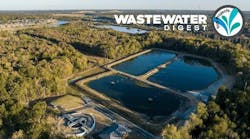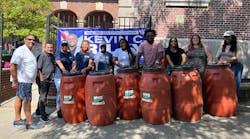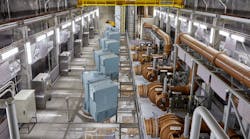To understand combined sewer overflows, it is important to first understand combined sewer systems. These systems collect rainwater runoff, domestic sewage and wastewater into one pipe.
CSO basics
According to the United States Environmental Protection Agency (EPA), combined sewer overflows, often referred to as CSOs, happen when the amount of runoff exceeds the capacity of the system and untreated storm and wastewater flow into nearby waterbodies.
CSOs are subject to the National Pollutant Discharge Elimination System (NPDES) permitting program, and the Clean Water Act requires communities with CSOs to put controls in place to address pollution concerns. The NPDES program created a framework, called the CSO Control Policy, that makes clear expectations, water quality standards, and NPDES authorities. The CSO Control Policy has two phases.
According to the EPA, Phase I requires communities with CSOs to identify and implement nine minimum controls, which are technology-based controls to reduce water quality impacts; develop a long-term control plan to achieve water quality standards compliance; and submit this plan to the NPDES permitting authority. In Phase II, communities must continue to enforce the nine minimum controls, implement their long-term plan and conduct monitoring to verify water quality standards are being met.
How do you mitigate CSO impacts?
When it comes to solving CSOs, there are multiple ways communities can act, including:
- Green/gray infrastructure
- Integrated planning
- Smart data infrastructure
- Smart sewers
- Real-time notifications
Take the Chicagoland area as an example. On a dry day, the Metropolitan Water Reclamation District of Chicago can treat 1.4 billion gallons of wastewater across its three reclamation plants. According to the Friends of the Chicago River website, as little as 0.3 inches of rain can trigger a sewer overflow at numerous locations out of the more than 300 outfalls that flow into the Chicago and Little Calumet rivers.
To address overflows, MWRD has constructed more than 17 billion gallons of stormwater capacity through its Tunnel and Reservoir Plan. When stage 2 of the McCool Reservoir is completed, likely in 2029, the system will have a combined sewage capacity of 17.5 billion gallons, which is more than 4,666 gallons for each person in its service area, the MWRD said.
As another example, let’s look at Kentucky. Louisville MSD is known as an early-adopter of real-time control (RTC) to reduce CSOs. Consistently, the RTC system aids MSD in maximizing its conveyance, storage and capacity to reduce CSOS, an EPA report said. This has helped MSD annually capture more than 1 billion gallons of CSO volume and save about $200 million.
And, as final example, Buffalo, New York, saved $145 million by using a digital system by Xylem that redirected excess rainwater to underused parts of its system to prevent overflows. Buffalo Sewer Authority (BSA) utilized machine learning, hydraulic modeling and data analytics through Xylem’s Wastewater Network Optimization System to upgrade its network and create a real-time decision support system.
What is the difference between a CSO and an SSO?
Michigan's Department of Environment, Great Lakes and Energy defines a sanitary sewer overflow (SSO) as “discharges of raw or inadequately treated sewage from municipal separate sanitary sewer systems, which are designed to carry domestic sanitary sewage but not storm water. These overflows may also contain industrial wastewater that is present in the sewer system.”
While SSOs do typically involve wet weather, municipal separate sanitary sewer systems are not designed to manage stormwater. Another difference between the two is how they are caused. While CSOs are often started by extreme weather conditions, SSOs can be caused by the following:
- Blockages
- Line breaks
- Sewer defects
- Power failures
- Improper design
What are the impacts of CSOs?
While the goal is to mitigate CSOs from occurring, they do happen. When they do, they can have a myriad of effects.
“CSOs are a major water pollution and public health concern for approximately 700 communities in the United States,” the EPA’s website said.
CSOs can contain bacteria, debris and other hazardous substances that can harm humans and wildlife and can also result in beach closures, algae growth, reduced oxygen levels in waterways and more.
According to the PennState Extension website, “combined sewer systems were never designed to handle all of the water during wet weather flows and a number of overflow events were expected; however, growth of urban centers as well as an increase in extreme rainfall events have exacerbated CSO events.”
With various techniques to help stop CSOs and their negative impacts, communities can be well-equipped to mitigate these events from happening, but capacities of drainage networks and wastewater treatment plants cannot always function at the levels needed, especially with more frequent and intense storm events.
As the PennState Extension website said, while communities operating these systems are responsible for managing CSOs, residents can help as well by installing rain barrels, making rain gardens and more.







